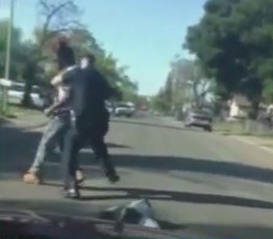Last week, another brutal video hit social media, showing a police officer knocking down and punching a man in Sacramento for the horrendous crime of jaywalking.
It's depressingly far from the first time something like this has happened.
The fallout from the video has been intense, and the officer has been put on leave “while the incident is being investigated.” Viewing the video raises many questions, in part because the man seemed to be legally crossing the street. Did the cop stop him because a car zoomed by in front of him as he crossed? But then, why not go after the car driver? Or did he stop the man because he is black?
It's likely to be the latter, and that's the story statistics tell. Despite vehement denials by a police spokesperson that race had nothing to do with jaywalking citations, the Sacramento Bee reported that the Sacramento police give more jaywalking tickets to black people than their percentage of the city's population would warrant.
The article quotes a police union representative who points to the “broken windows” theory of policing, saying that “stopping people for minor infractions [is] a proactive way to lower crime.”
If we want to keep crime down, we need to make those stops... It’s the little things, like jaywalking and minor traffic violations. If you look into those, you will find a lot more.
So the police are stopping jaywalkers not because jaywalking itself is a problem, but because it's an excuse to stop people and search people and run warrants. Holy moly.
Asked about the locations where the most jaywalking citations are issued, the police spokesperson told the Bee that those areas include major thoroughfares
that are potentially hazardous to cross, and where crosswalks may be less common... And where there's a lot of foot traffic.
In other words, where being a pedestrian is unpleasant but necessary.
Pedestrians will often cross the boulevards wherever instead of walking down to the crosswalk where it’s safe and lawful.
Of course, “walking down to the crosswalk” could mean going a good quarter mile out of your way, frequently without any shade, to a place where it's “safe and lawful” only because a signal commands cars to stop at regular intervals. Even at a crosswalk, the opposite corner can be a long distance away across a bleak expanse of hot pavement. But paint on the ground and a signal above are poor guarantees of safety in the presence of distracted, incompetent, or impatient drivers.
That quarter mile out of your way quickly becomes a half mile if you need to retrace your steps on the other side. Add a bag of groceries and maybe a couple of tired kids. No wonder people are tempted to jaywalk.
In Sacramento, the statistics say that jaywalking citations are more likely to be issued to black people in parts of town where jaywalking is a logical response to bad infrastructure. And by their own admission, cops issue those citations not to keep pedestrians safe--this is not about Vision Zero. It's about checking to see if there is something else the cops can pick them up for.
As a society we are starting to understand that people of color don't feel safe on our streets for a lot of reasons that don't affect other people, including fear of being stopped by the police. It's time for police departments in our cities to grapple with that, and rethink their approach to their job.
And it's also time to rethink the harm from criminalizing jaywalking. Is crossing the street really a criminal issue? Are people who cross streets in the manner of any reasonable person destroying the safety and integrity of our communities? Are they committing a crime that puts us all in danger?
No, they are not.






